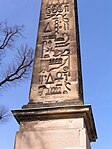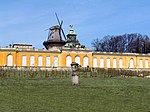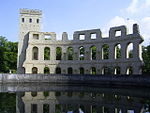Church of Peace, Potsdam

The Protestant Church of Peace (German: Friedenskirche) is situated in the Marly Gardens on the Green Fence (Am Grünen Gitter) in the palace grounds of Sanssouci Park in Potsdam, Germany. The church was built according to the wishes and with the close involvement of the artistically gifted King Frederick William IV and designed by the court architect, Ludwig Persius. After Persius' death in 1845, the architect Friedrich August Stüler was charged with continuing his work. Building included work by Ferdinand von Arnim and Ludwig Ferdinand Hesse also. The church is located in the area covered by the UNESCO World Heritage Site Palaces and Parks of Potsdam and Berlin. The cornerstone of the churchhouse was laid on 14 April 1845. The building was dedicated on 24 September 1848, though construction continued until 1854. The structure resembles a High Medieval Italian monastery.
Excerpt from the Wikipedia article Church of Peace, Potsdam (License: CC BY-SA 3.0, Authors, Images).Church of Peace, Potsdam
Am Grünen Gitter, Potsdam Brandenburger Vorstadt
Geographical coordinates (GPS) Address Nearby Places Show on map
Geographical coordinates (GPS)
| Latitude | Longitude |
|---|---|
| N 52.400833 ° | E 13.043333 ° |
Address
Kreuzgang / Atrium
Am Grünen Gitter
14469 Potsdam, Brandenburger Vorstadt
Brandenburg, Germany
Open on Google Maps











